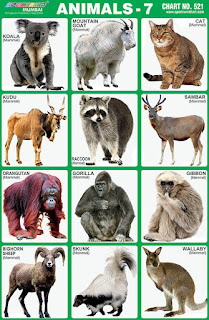Koala (Mammal) - Koalas are
native to Australia and live in eucalyptus forests. They have poor
eyesight, but excellent sense of smell, which helps them find type
of eucalyptus they like to eat. Koalas spend most of their time in
trees. They sleep 16-18 hours per day. They are nocturnal animals.
Mountain Goat (Mammal) -
Mountain goat also known as the Rocky Mountain goat, is a large
hoofed mammal endemic to North America. Mountain goats have beards,
short tails, and long black horns. Mountain goat's feet are
well-suited for climbing steep, rocky slopes with pitches.
Cat (Mammal) - Cats are
common pets worldwide. The average domestic cat sleeps for around 18
hours a day. Cats have excellent night vision and can see at only
one-sixth the light level required for human vision.
Kudu (Mammal) - Kudu is a
type of an antelope. Kudu can be found in eastern and southern parts
of the Africa. Kudu is easily recognised by its long, spiral horns.
They can reach 72 inches in length, making 2 ½ twists. Kudu is
herbivorous animal which consumes mainly grass, roots, leaves,
fruits and tubers.
Raccoon (Mammal) - Raccoon
are native to South and North America. They have greyish fur, black
mask around eyes and long tail covered with black and brown bands.
Because of their tail, they are nicknamed "ringtail". They
are omnivores and nocturnal creatures.
Sambar (Mammal) - Sambar
deer is one of the largest members of deer family. Body of sambar
deer is covered with yellowish brown or dark brown coat. Spots and
markings can be seen on the lateral sides of the body.
Orangutan (Mammal) -
Orangutans are large, red coloured Apes. They are the only group of
Great Apes that live outside the Africa. There are two types of
orangutans: Sumatran and Borean orangutans. Both species are
critically endangered because of poaching and loss of habitat.
Orangutans are the largest arboreal mammals. They are herbivore. 50%
of their diet consists of fruit.
Gorilla (Mammal) - Gorillas
are large apes that are native to Africa. Gorillas are herbivores
and eat leaves, shoots, roots, vines and fruits. It is said that the
DNA of gorillas is 98-99% identical to human DNA. Their lifespan
ranges between 35 - 50 years.
Gibbon (Mammal) - Gibbon is
a small ape. It lives in tropical rainforests & dense jungles.
Number of gibbons in the wild is very low because of the accelerated
deforestation and poaching. Gibbons are often sold as pets. They are
arboreal animals. Gibbons are omnivores, Their diet consists mainly
of fruit, but they also eat different types of seed, shoots, flowers
and insects.
Bighorn Sheep (Mammal) -
Bighorn sheep is a species of sheep native to North America named
for its large horns. They range in colour from light brown to greyish
or dark, chocolate brown, with a white rump and lining on the backs
of all four legs.
Skunk (Mammal) - Skunks are
mammals that can be easily recognised by their black and white
coloured fur. They live in North and Central America. Skunks are
omnivores. They like to eat fruits, insects, worms, reptiles and
rodents. They have poor eyesight, but they have excellent sense of
smell and hearing.
Wallaby (Mammal) –
Wallaby is a small- or mid-sized macropod found in Australia and New
Guinea. They belong to the same taxonomic family as kangaroos.
Wallabies are herbivores whose diet consists of a wide range of
grasses, vegetables, leaves & other foliage.


No comments:
Post a Comment